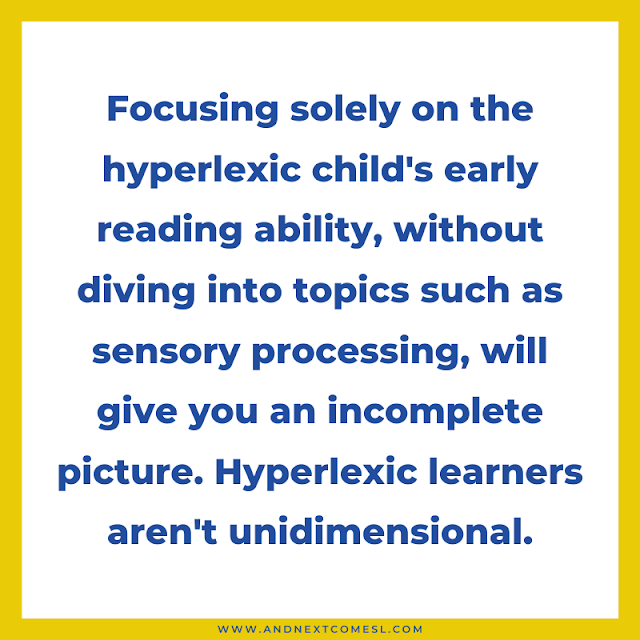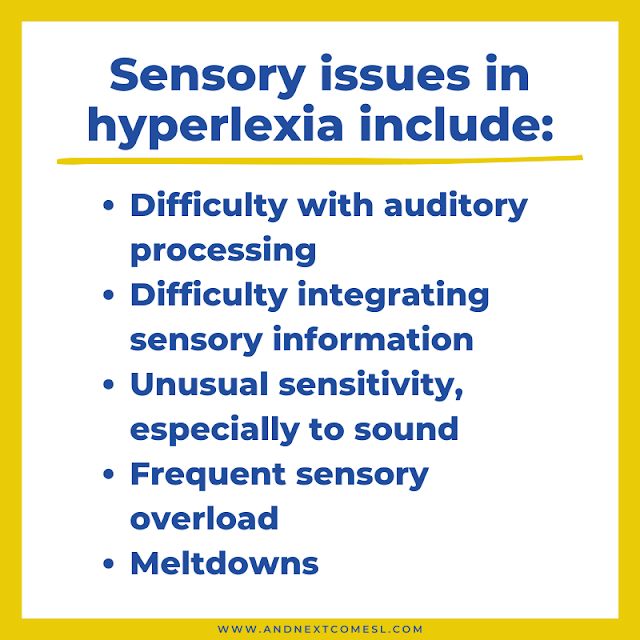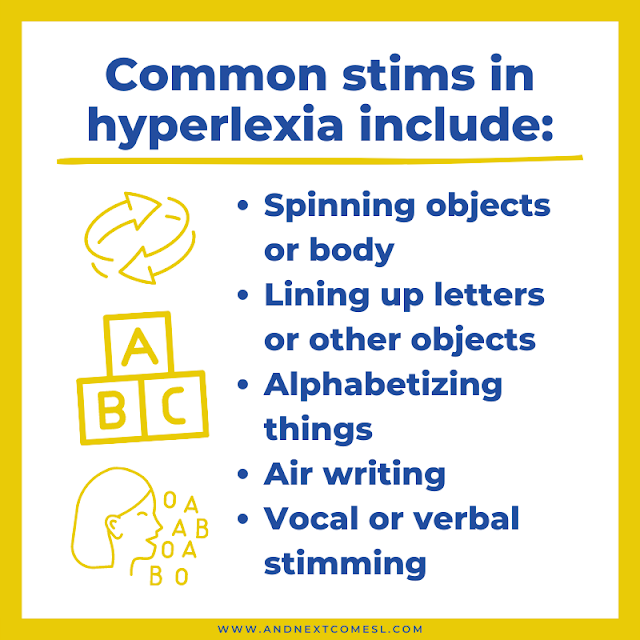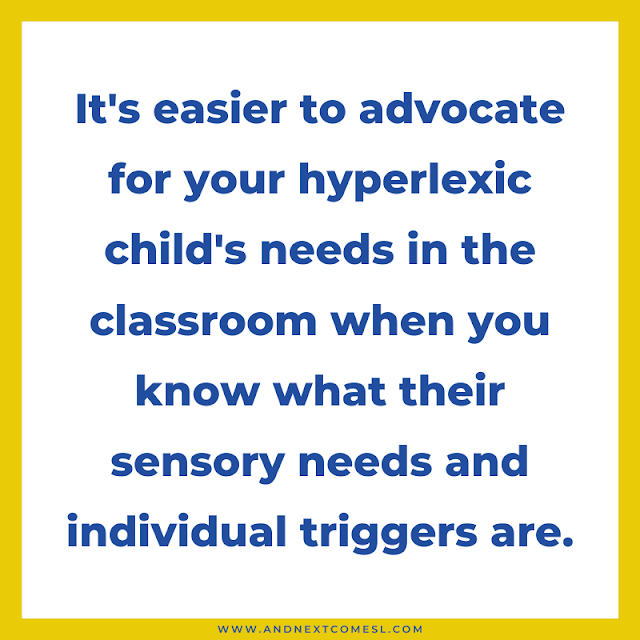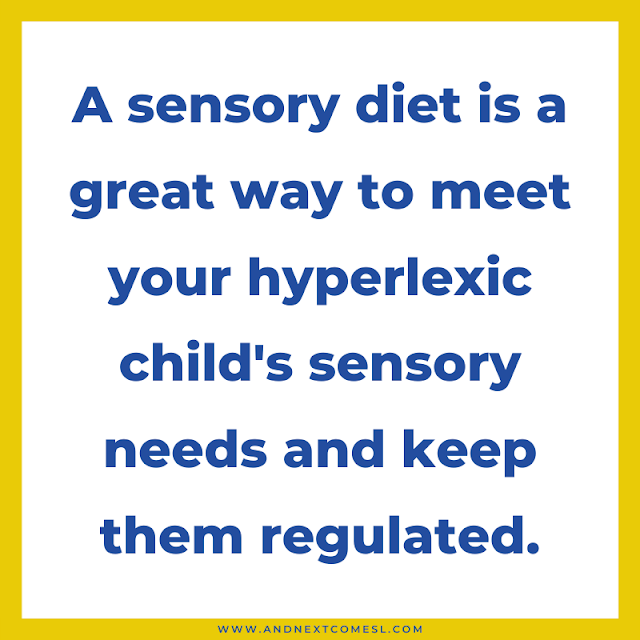Many - if not all - hyperlexic children have specific sensory needs.
That's probably not surprising to you given that sensory processing issues are common in autism and that most hyperlexic kids are also autistic.
So we can't really talk about hyperlexia without talking about sensory processing at some point.
Just like we can't talk about hyperlexia without talking about comprehension, echolalia, gestalt language processing, or autism.
Obviously, there are many things to learn about when it comes to hyperlexia, especially if you want to best support a hyperlexic learner.
But focusing solely on their early reading ability without diving into these other topics will give you an incomplete picture. Hyperlexic learners aren't unidimensional after all.
So let's take a closer look at hyperlexia and sensory processing. We'll cover some common sensory issues found in hyperlexia and dive into the basics of sensory processing.
An Overview of Sensory Issues in Hyperlexia
Some sensory issues that you might notice in hyperlexia include:
- Difficulty with auditory processing
- Difficulty integrating sensory information
- Unusual sensitivity, especially to sound
- Frequent sensory overload
Stimming is also common in hyperlexic kids and is often used to help with sensory integration and self-regulation (see point #2 here). Common stims in hyperlexic kids include:
- Spinning objects or even their body
- Lining up letters or other objects
- Alphabetizing things
For some hyperlexic kids, there might not be any obvious or big sensory issues that you notice. However, your child's stimming behaviors may indicate underlying sensory processing issues that are more subtle or less obvious. So please be aware that your child may stim as a way to integrate and cope with sensory information.
Often, hyperlexic kids are "so busy seeking out specific types of sensory inputs that they cannot attend to the relevant information at hand" or "have such low energy levels that they find it difficult to focus on what is happening around them." (source: Hyperlexia: Therapy that Works manual)
As a result, these sensory issues in hyperlexia can "affect learning and lead to misinterpretation." (source: What is hyperlexia? pamphlet). That's why it's so important to learn about the unique sensory profile of your hyperlexic child.
In order to understand your hyperlexic child's sensory needs though, you first need to know the basics of sensory processing.
What You Need to Know About Sensory Processing
One of the first things you need to know is that there are actually 8 senses, not five like we learned as kids.
There's the sense of smell (olfactory), sight (visual), sound (auditory), touch (tactile), and taste (gustatory) like you're familiar with. But we also have an internal body sense called interoception, a sense of balance called vestibular, and the body awareness sense called proprioception.
Everyone processes and responds to their senses differently, not just hyperlexic kids. Some might seek out specific types of sensory input or avoid them altogether. Others may be extremely sensitive to all sorts of sensory input. Or maybe they don't even recognize or process incoming sensory information. We call these patterns of sensory processing.
Perhaps you've heard of the terms sensory avoiding or sensory seeking before. Well, that's what we're talking about when we talk about these patterns of sensory processing.
So your hyperlexic child might be under responsive and crave sensory input, making them a sensory seeker. Think of the child who is hanging upside down off the couch, spinning in circles, or chewing on things constantly.
Or they might be over responsive and find sensory input distressing. In that case, they're a sensory avoider. Examples include covering ears when it's too loud, picky eating, or disliking tight clothing or hugs.
They may also be reactive to all types of sensory input and notice things that others don't. That would make them sensory sensitive. For example, they may squint when the lights are too bright or hear the fainting buzzing of fluorescent lights.
Then finally, there's low registration, where sensory input isn't recognized or processed. With this pattern, a child might not notice food on their face or they may appear lethargic.
It's important to note that a child can present with a combination of these sensory processing patterns. For instance, they may be both a sensory seeker and a sensory avoider. Or they may be over sensitive one day and under sensitive the next. You can read more caveats about the patterns of sensory processing here.
The main point though is to try and identify how your hyperlexic child responds to various types of sensory input. Because once you know this information, it's much easier to identify what your child's sensory triggers might be and what might lead to sensory overload or cause a meltdown.
Also, once you know your hyperlexic child's triggers, it's much easier to recognize the signs of sensory overload and find the right coping strategies for them to use.
You'll also be better able to advocate for your hyperlexic child's needs in the classroom because you know what accommodations or modifications might be the most suitable based on those sensory needs or their individual triggers.
Finally, you can help meet your hyperlexic child's sensory needs and keep them regulated using a sensory diet, which is an individually tailored plan of activities designed to meet their sensory needs. But the only way to create an effective sensory diet is to understand their sensory needs and how they process incoming input.
Please note, it's best to consult with an occupational therapist for advice regarding a sensory diet for your hyperlexic child. You should also try to incorporate the child's special interests if you can. So, in the case of the hyperlexic child, that might mean incorporating letters or numbers. Of course, right?
Hyperlexia and Sensory Processing: A Quick Recap
Learning about sensory processing and how it impacts your hyperlexic child can be quite overwhelming. But it's really important that you do to ensure your child is properly supported, whether that's at home, in the classroom, or while out and about.
So remember, there are 8 senses, not 5.
There are also different patterns of how one might respond to sensory input for these 8 senses, including sensory seeking and sensory avoiding.
Knowing how your hyperlexic child reacts to certain stimuli can help you identify their sensory triggers and avoid sensory overload as much as possible. It can also help you advocate for proper classroom accommodations and create a sensory diet plan that works.
Your hyperlexic child may need further support with sensory processing and may benefit from occupational therapy. So it's always best to get an OT assessment done so you can truly understand how hyperlexia and sensory processing impacts your child.



